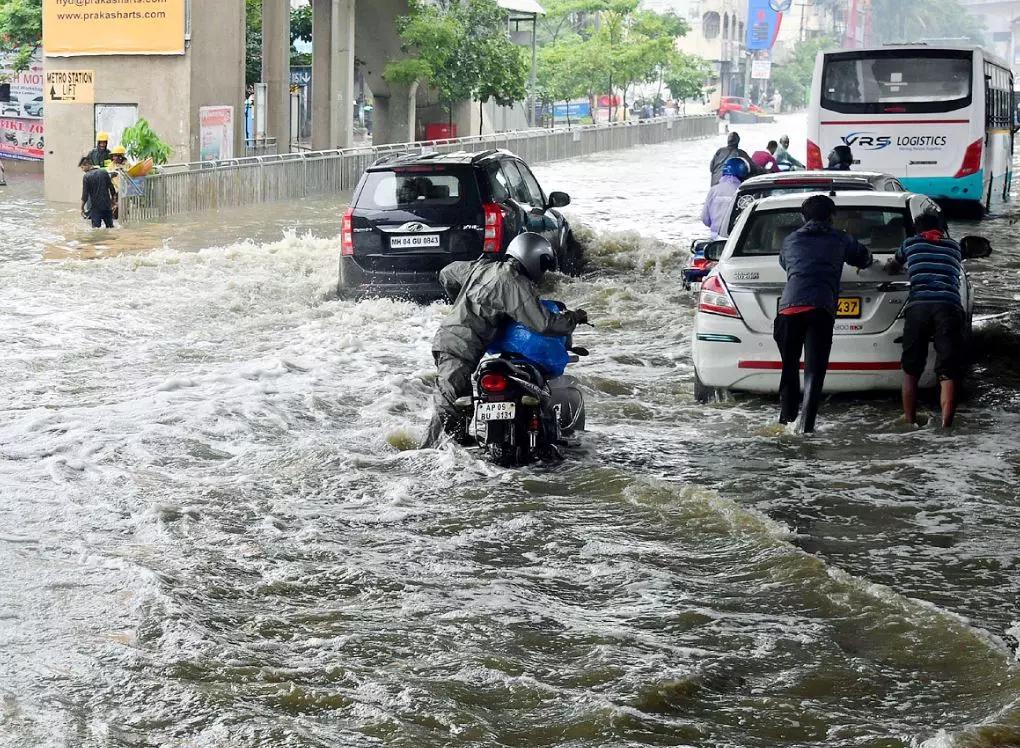Extreme weather conditions claimed 66 lives in TG so far this year
Centre for Science and Environment comes up with shocking climate change revelations

HYDERABAD: Telangana has faced a punishing year of extreme weather so far, with deadly rains, scorching heat waves, and severe storms, which together claimed 66 lives, damaged 73,418 hectares of agricultural land and caused extensive infrastructure damage.
The state endured 50 days of extreme weather, reflecting India’s broader climate crisis as documented in the “Climate India 2024: An Assessment of Extreme Weather Events” report by the Centre for Science and Environment (CSE).
Across the nation, there were 255 extreme weather days from January to September. The national data indicated that extreme weather was recorded on 93 per cent of days in this period, leading to 3,238 deaths and affecting 3.2 million hectares of crops across the country.
In Hyderabad, heavy rainfall resulted in widespread waterlogging, turning roads into rivers, flooding homes, and bringing life to a standstill. Transport networks paralysed and businesses hit hard.
Urban experts said in the report that the existing drainage systems were overwhelmed, exacerbating the damage and leaving the city vulnerable to near-catastrophes.
Telangana’s agricultural sector suffered immensely. The combination of intense pre-monsoon heat waves and excessive rainfall during the monsoon caused severe damage to crops. During heat waves, temperatures surged beyond seasonal norms, scorching fields and reducing yields. When the rains finally came, they did so in extremes. They triggered floods that submerged fields and destroyed crops. Reports from the CSE assessment show that 73,418 hectares of land, including key staples like paddy and maize, were ruined, pushing countless farmers into financial distress.
Beyond agricultural damage, the state reported major infrastructure losses. Over 10,000 homes were damaged by floods and heavy rains, displacing families and causing economic strain. Districts like Karimnagar and Nizamabad suffered frequent power outages as strong winds and rains damaged electricity lines and substations.
Hyderabad’s infrastructure challenges stood exposed. Drainage upgrades, planned after major floods in 2020, remain incomplete. The flooding has led to a sanitation crisis, raising public health concerns due to stagnant water and increased risks of disease outbreaks.
According to the CSE report, Telangana’s experience is part of a broader trend across the peninsula, which faced 168 days of extreme weather, resulting in 762 deaths and damage to over 425,620 hectares of crops.
Its struggle points to the escalating impact of climate change-driven weather events. National temperature records for 2024 were shattered, with May’s average maximum temperature in India touching 37.32°C, while unprecedented heavy rains brought further destruction.
The “Climate India 2024” report called for a shift from reactive disaster management to proactive measures aimed at risk reduction and climate adaptation.
Officials from the state have proposed significant investments in flood management infrastructure, such as building reservoirs and expanding green spaces to serve as natural water buffers. The report also highlighted the need for global climate action and support from high-emission countries to address local impacts effectively.
The upcoming winter also poses potential challenges for the state. The South Peninsula, which includes Telangana, recorded its fourth warmest January earlier this year, reflecting the climate’s growing unpredictability. There is a possibility of temperature swings and more episodes of unusual conditions, underscoring the need for continued climate resilience and adaptive measures.
Economically, the toll of these events is severe. Nationwide, 3.2 million hectares of crops were impacted. While Telangana’s damage was less extensive in comparison to states like Maharashtra, it remains a reminder of the human and economic cost of a changing climate.

